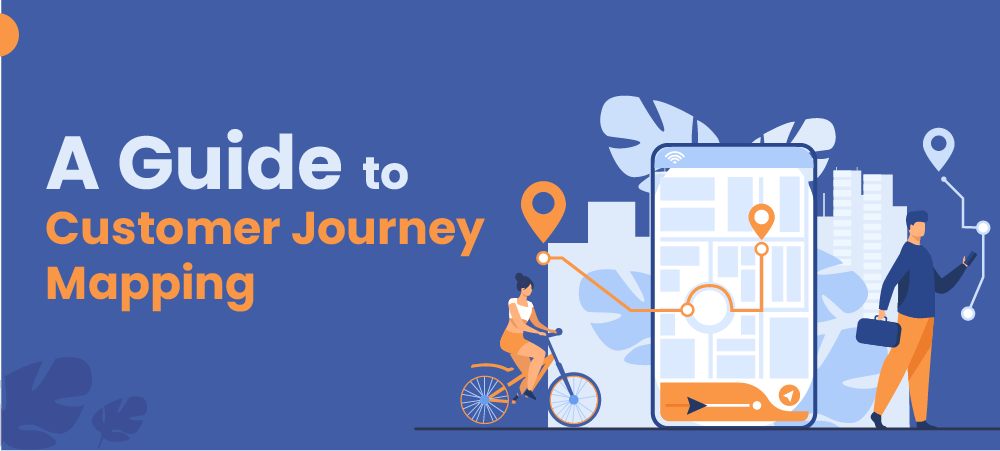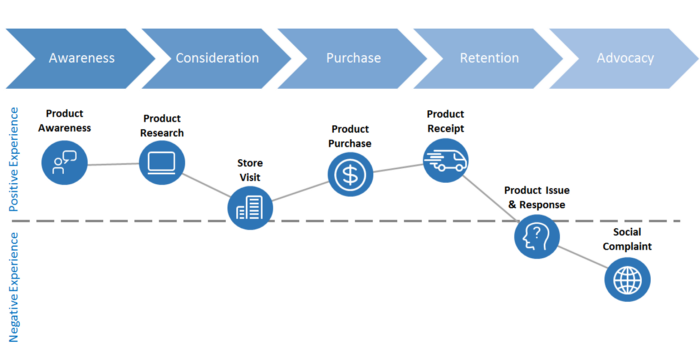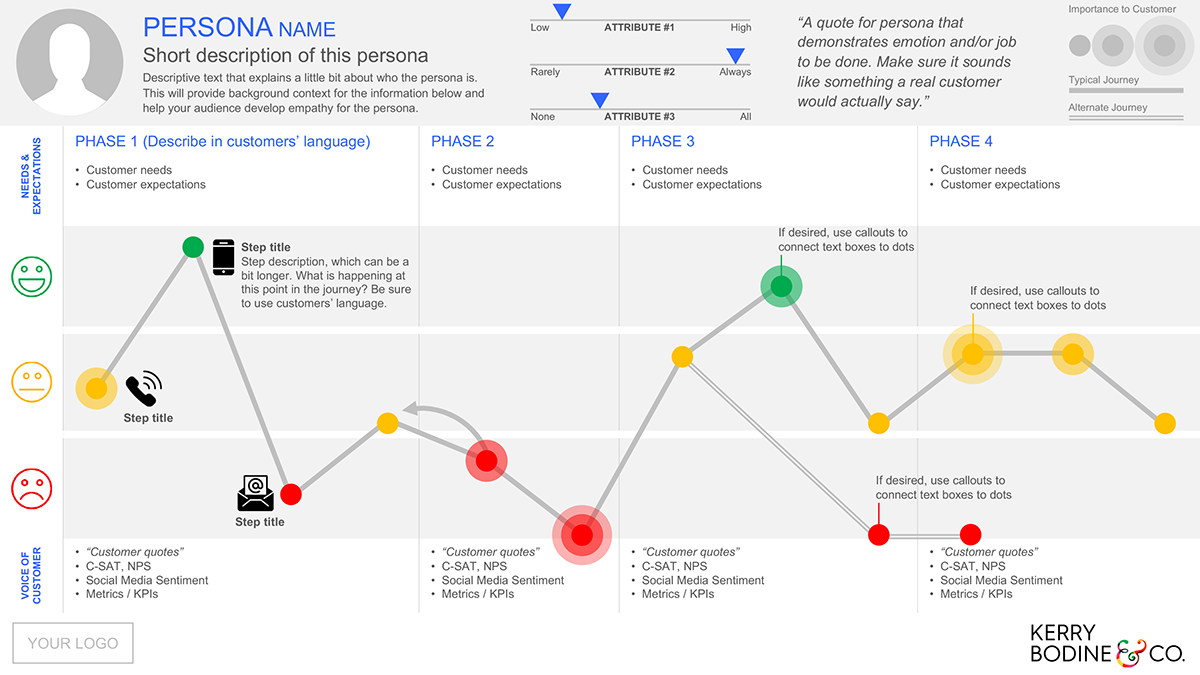With customers interacting with companies through more and more channels, keeping track of everything and delivering the best experience has become complicated.
That’s where customer journey mapping comes in. It helps brands understand the customer journey, stay on top of their expectations and optimize the customer experience.
Read on to find out what customer journey mapping is, why it is so important, and how to create a customer journey map.

What is Customer Journey Mapping?
Customer journey mapping is a visual representation of how customers interact with your brand. It tells you where and how customers communicate with your business. With a clear understanding of how a customer journey looks like, and by putting yourself in your customers’ shoes, you can define a strategy to improve the customer experience.
Believe it or not, customers nowadays use up to 10 channels to communicate with businesses. It is no longer about putting out a product and having someone buy it. Things have become much more complex. That is why a visual representation of customer interactions across all touchpoints (offline and online) helps connect the dots and deliver a consistent experience.
A visual representation of how customers interact with your brand
Today, brands use email marketing, social media, live chat, customer satisfaction surveys, and more to interact with customers.
Every interaction a customer has with your brand, regardless of the channel, is called a customer touchpoint. Ideally, you should not only know them but be able to “read” these points with all the others.
The solution for keeping track of these touchpoints and transforming them into valuable information is called customer journey mapping.

Types of Customer Journey Maps
Always choose your customer journey map type based on your needs and possibly even marketing attribution. We’ll get into more detail on that in the subsequent section. For now, here are the four types of customer journey maps you can choose from:
1. Current State
This type of customer journey mapping is ideal for streamlining the customer journey. It shows you the actions taken by your customers, along with their thoughts and emotions, while going through the customer journey.
2. Day in the Life
As the name suggests, this customer journey map gives you an overview of a day in your customer’s life. It also shows you the actions, as well as the thoughts and emotions experienced by your customers. However, it reveals this information not only for your brand but for everything else as well.
You can use this map to identify the needs that you can address with your products or services.
3. Future State
This type of customer journey map works best for setting future goals for your brand. You can use it to identify where your customer experience is now and where you visualize taking it in the future.
4. Service Blueprint
Service Blueprint maps illustrate how you intend to improve the customer journey. It includes pain points, the steps required to achieve the intended goals, and who is responsible for achieving those goals.
It is ideal for streamlining the customer journey as it shows you the actions taken by your customers, their thoughts, and emotions throughout their journey with your brand.
Why is Customer Journey Mapping Important?
The key to a better and bigger business is to understand the customer. Once you know them, you can optimize and personalize their journey and experience. The result? Better customer retention and more new customers.
Customer journey mapping will help you do just that: understand your customer.
By visualizing how a customer interacts with your business, you understand their first-hand experience. You can clearly see their perspective and motivation. In doing so, you’ll also identify pain points, weak spots, or areas where the customer journey can benefit from improvement and tailor your call to action accordingly.
Customer journey mapping is essential to get the customer’s perspective. The insights gained from this exercise can help you better organize and optimize your processes, resulting in better business.
This strategic approach can help you:
- understand customer expectations
- identify pain points
- personalize your offers
- customize multi-channel marketing strategies
- streamline the customer experience
- retain more customers
- acquire more customers
- surpass your competitors
Customer Journey Mapping Benefits
Customer journey mapping has a multitude of benefits. You can use it to set up and improve all the steps of a customer’s journey starting from the very beginning.
Because customer journey mapping is all about understanding the customer, it can help streamline everything from the customer onboarding process to the check-out process.
1. Improve Your Customer Service
No matter how good your customer service is, it can always be better. And with customers now expecting superior customer support, you cannot afford not delivering it. Customer support is one of the main factors that determine whether a customer will return or not.
Customer journey mapping is a great way to identify the gaps in your customer service. Use it to map out each touchpoint a customer goes through. Then, take the journey yourself.
It will help you determine:
- what needs to change
- how to implement the required changes
- who will do it?
2. Increase Customer Retention Rates
Better customer service alone can help improve retention rates. However, customer journey mapping does even more.
You can use it to understand the customer’s point of view. And with this info, you can optimize their journey and personalize it.
First, it helps you identify common issues that can cause your customers to leave. This way, you can implement the necessary changes to avoid the same and persuade customers to stay.
Second, with customer journey mapping, you better understand the thoughts and emotions of your customers. It can translate into better marketing strategies focused on personalized experiences that ensure increased retention rates.
3. Attract More New Customers
Following the same logic, you can also acquire new customers.
Once you know what customers want and their expectations, you technically have everything you need for efficient marketing strategies. You can tailor your marketing efforts to their needs, desires, and emotions and attract a larger audience for your products/services.
How to Create a Customer Journey Map?
The customer journey map will tell you how your customers go through each process, what kind of needs drive them to you and what steps they need to meet that need.
This visual representation of their journey is a valuable resource for your entire organization. Any startup can create a customer journey map by following the steps described below or in this friendly workshop.
1. Start with Clear Objectives and Goals
First, start by understanding what it is you want to achieve by creating a customer journey map. Ask yourself what specific stage of the customer journey you want to tackle. Or what is your main goal for the information you will get.
Once you have a clear direction, dive into creating the map.
List all the touchpoints a customer will pass through. It could be your website, your social media pages, their interactions with customer support.
Next, create different buyer personas. A buyer persona is an imaginary customer who encompasses the main characteristics of your typical customer. It will help you understand each step of the customer journey from their perspective.
Then take these buyer personas through every touchpoint.
For example, if the buyer is in their 30s, they’ll likely learn about you on social media. Then they will use the mobile version of your website to find out more. Finally, they will make a purchase from their laptop.
Your goal should be to identify:
- what attracts people to your brand
- what specific needs your product can meet
- where customers interact the most with your brand
- how much time they spend interacting with your brand
- what drives them to make a purchase
- what prompts them to refuse a purchase
- How valuable your customer support service is and how you can improve it

2. Create a Specific Target
While having multiple buyer personas can be helpful, avoid focusing on too many.
Pick a few primary target personas for your customer journey map. This way, you won’t get lost in too many details, and you can focus on your goals. It is essential to focus on a single perspective to understand the client’s thoughts and emotions and their specific needs.
Plus, once you master customer journey mapping, you can always use it for more customer personas.
3. Identify all the Touchpoints
Next, you need to list all the touchpoints that the customer has to go through.
Touchpoints can include:
- Website
- Social media pages
- Email marketing
- Online ads
- Review websites
Go into as much detail as possible. Don’t just list the website, for example, but list all the ways a customer can interact with you through one channel. It can be via a contact form, a live chat, a chatbot, and more.
Also, map out all the actions that a customer will take during their journey. For example, a Google search or a click on an ad on social media.
It will help you understand what steps your customers are taking. Then, you can identify what works and what does not at individual steps.
The number of steps is also important. You might find that while you offer many touchpoints, your customers only use a few.
This may indicate that something along the way is causing them to bail. Or it could mean that they can easily find what they are looking for and don’t need much else. Your conversion rates will give you the answer.
Likewise, you might find that customers go through more touchpoints than they need. In this case, try to identify how you can streamline their journey.
4. Understand What Triggers Customer Actions
Perhaps the most critical part of the customer journey map is understanding the “why”.
It is not enough to list the touchpoints. You will also need to understand your client’s perspective on each of them. What motivates a customer to go through each touchpoint is as important as the emotions they feel.
Ask yourself what thoughts and emotions drive the customer at each touchpoint. Each step of the buyer’s journey is different, and so are the emotions.
Then, ask yourself:
- Do your touchpoints match the customer’s needs and motivation?
- What about their emotions?
- Is the customer well-tended to at each touchpoint?
- Is the information provided to them is sufficient?
- What about the support?
- Does something trigger negative emotions?
Just as a problem brought them to your product/service, a problem can drive customers away.
For example, they may visit your website because they need a new backpack. Their motivation is clear. They want to buy a new one.
However, by browsing your pages, they don’t find all the information they need. Now they are frustrated. They want to contact customer support, so they’re figuring out how to do it. If they cannot find this information or reach your support and get through, they will become frustrated and might go to the competition.
Creating a clear roadmap of each point the customer goes through and considering each one’s emotional triggers will help avoid common mistakes and optimize the customer journey.
5. Define Your Future Needs
Your customer journey map should reveal where you need to implement the changes required.
In this case, you also need to define the steps and processes necessary to improve your customer’s journey.
So, determine what resources you already have and what resources you will need.
It could be just a few simple steps to a better customer experience. For example, highlighting certain information on your website or making it more obvious to potential customers how to purchase.
In other cases, you will need additional resources. For example, if your customer journey map reveals that many customers decide not to buy because of poor customer support. In this case, you may need to invest in more customer service training or hire more staff. However, add more support options like a chatbot on your website.
Finally, your customer service card will also help you influence decision-makers, as you can show how implementing the required changes can improve the customer experience.









![[Webinar] Sales Automation 101: Unclog your Sales Pipeline](https://www.leadsquared.com/wp-content/uploads/2024/04/automation-webianr-popup.gif)
